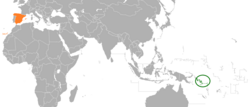Solomon Islands–Spain relations
 | |
Solomon Islands |
Spain |
|---|---|
Solomon Islands–Spain relations are the bilateral and diplomatic relations between these two countries. The Solomon Islands do not own embassy resident in Spain, but have a representation in Madrid through their honorary consulate.[1]
Historical relations[]

In 1567 he left El Callao an expedition commanded by Álvaro de Mendaña, taking Pedro Sarmiento de Gamboa as captains of the ships and in search of Terra Australis Incognita and study the possibilities of colonization and exploitation of its resources. On 7 February 1568 the two ships of the expedition, Los Reyes and Todos los Santos arrived at the first of the islands of the archipelago. The island was baptized with the name of Santa Isabel. For six months they explored Palm Island (), San Jorge (south of Santa Isabel), Florecida, Galera, Buenavista, San Dimas, and Guadalupe (group of or Nggela Sule ), , Sesarga (Savo), San Nicolás Islands, San Jerónimo and Arrecifes (group New Georgia ), San Marcos (), San Cristóbal (Makira), Treguada (Ulawa), Tres Marías (), San Juan ( Uki Ni Masi), San Urbán (Rennell), Santa Catalina and Santa Ana.
Álvaro de Mendaña tried to prepare a second expedition to Solomon to colonize them and prevent them from serving as a refuge for pirates English who attacked the Spanish ships that traded with the Philippines . It was the viceroy of Peru, García Hurtado de Mendoza, who authorized and sponsored the expedition, contributing military personnel, while Mendaña himself convinced merchants and settlers to participate in the company. The ships left El Callao in 1595 and after discovering the Marquesas Islands, named in honor of the viceroy and marquis of Cañete, and passing through the Cook Islands and Tuvalu, they arrived at Santa Cruz Islands, south of Solomon.
The ship Santa Ysabel was lost on the island of Tinakula, however they came to found a colony, called Puerto de Santa Cruz, in the Santa Cruz Islands, in the current province of Temotu. Soon, Mendaña became ill with malaria and the settlers came into conflict with the natives. On 18 October 1595 Mendaña died on the island of Nendö and his wife, , took over the colony. After these events, they decided to leave the islands and go to Manila.
After these expeditions the Spaniards lost interest in the islands, although they continued to visit them during the 17th century. There was a new colonizing attempt in 1606, led by Pedro Fernández de Quirós, who recast the Mendaña colony, but abandoned it with the intention of discovering and exploring Australia, in which he was unsuccessful. The islands were subsequently visited by British, French and Dutch.
Diplomatic relations[]
Spain established diplomatic relations with the Solomon Islands on 8 August 1980, but that country does not have a resident embassy, which is under the jurisdiction of the Spanish Embassy in Canberra and whose consular affairs are managed from the Spanish consulate general in Sydney.[2]
Relationship of visits in both directions[]
In July 2013, visit of a delegation from the Island of Guadalcanal to attend the twinning events between the Island of Guadalcanal, Solomon Islands and Guadalcanal, Seville.
In August 2012, a Spanish Delegation met with representatives of the Solomon Islands in the framework of the Pacific Islands Forum in Rarotonga, Cook Islands, and made an economic contribution to the financing of the PIF Secretariat.
In May 2013, official Credentials Presentation trip by Ambassador Enrique Viguera.
In March 2014, official visit of the Director General of North America, Asia and Pacific and Maria Moset, of the General Secretariat of Fisheries, Sub-Directorate General of Regional Fisheries Agreements and Organizations, Ministry of Agriculture, Food and Environment Environment, to hold bilateral meetings.[3]
See also[]
References[]
- ^ [1] List of foreign consulates in Spain.
- ^ Ficha de las Islas Salomón Office of Diplomatic Information. Ministry of Foreign Affairs and Cooperation. Section: Diplomatic relations.
- ^ Ficha de las Islas Salomón Office of Diplomatic Information. Ministry of Foreign Affairs and Cooperation. Section: Relationship of visits in both directions.
- Solomon Islands–Spain relations
- Bilateral relations of the Solomon Islands
- Bilateral relations of Spain
